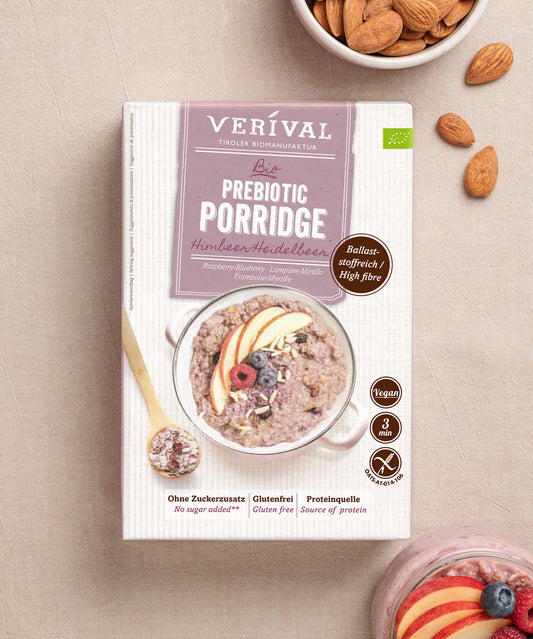Unsaturated fatty acids are considered healthy and important for a healthy diet. Even more than that, unsaturated fatty acids are essential for some important functions of the human body. Today, nutrition science agrees that unsaturated fatty acids should be found on everyone's menu.
This article will tell you exactly what makes unsaturated fatty acids so special, what role they play in your body and how you can easily integrate them into your diet.
Healthy fats for breakfast – find out more
Saturated and unsaturated fatty acids – the differences
Fats are crucial for our health and are therefore a basic nutrient. Fats only become unhealthy if you eat too many of them and, above all, eat too many of the wrong fats. The content of saturated and unsaturated fatty acids is important. A ratio of 1:2 (saturated and unsaturated fatty acids) is optimal. It is best if more than a third consists of monounsaturated fatty acids (oleic acid).
The difference between these two types of fat lies in their chemical structure and the associated absorption capacity of the human body. Monounsaturated fatty acids are found, for example, in avocados, peanuts ( nuts 1 ) or olive oil and are easily digestible for your body. They help you absorb fat-soluble vitamins and also protect your organs.
While your body can also produce monounsaturated fatty acids itself, it relies on an intake of polyunsaturated fatty acids through food. It is therefore particularly important that you consume polyunsaturated fatty acids through your diet. These include, in particular, the well-known omega-3 and omega-6 fatty acids, which are found, for example, in nuts or cold-water fish such as salmon or tuna. 2
Unsaturated fatty acids and their function
Unsaturated fatty acids are essential for your body. For example, they are a component of your cell membranes and ensure the necessary elasticity and permeability of the membranes. But your brain also needs unsaturated fatty acids to function properly.
In addition, polyunsaturated fatty acids play an important role in your body's anti-inflammatory processes. In some cases, the fatty acids in your body also develop into important hormones or contribute to cell division.
As you can see, the intake of these fats is essential for your body to carry out vital processes and for you to stay healthy. But what exactly do you need to watch out for in your diet?
Which foods contain unsaturated fatty acids?
Unsaturated fatty acids can be found in a wide variety of foods. Omega-6 fatty acids, for example, are found in various vegetable oils
- safflower oil
- sunflower oil
- wheat germ oil
- soya oil
- sesame oil and many more
and in some animal products
- pork
- beef
- chicken
- salmon
- mackerel
. The alpha-linolenic acid of omega-3 fatty acids can also be found in oils, but mainly in linseed oil, hemp oil, walnut oil and rapeseed oil. Furthermore, omega-3 fats are present in various types of fish (herring, tuna, sprat, salmon, mackerel, etc.).
It is particularly important for vegetarians and vegans to get their essential fatty acids from vegetable oils. If necessary, supplements can be added to the diet to help prevent cardiovascular disease. Polyunsaturated fatty acids reduce the risk of coronary heart disease, such as heart attack, according to the German Nutrition Society.
Are unsaturated fatty acids healthy?
In general, unsaturated fatty acids are quite healthy and can help your body prevent diseases and carry out vital processes. Since the body cannot produce polyunsaturated fatty acids itself, the German Nutrition Society recommends replacing the monounsaturated fatty acids with the polyunsaturated fatty acids.
However, caution is advised here: an excessive amount of omega-6 fat can increase inflammatory reactions in your body. Since most foods contain more omega-6 than omega-3 fatty acids, it is important that you consciously ensure that you take in enough omega-3 fats through your diet.
However, taking omega-3 supplements has not been shown to have any positive effects on heart disease. It is therefore sufficient to eat fish that contains omega-3 fats on a regular basis.
How can I incorporate unsaturated fatty acids into my diet?
First of all, it makes sense to look at which foods contain saturated and which contain unsaturated fatty acids. This way, you can be sure to avoid consuming too many saturated fats and, if necessary, simply replace some of the products in your diet.
In addition, vegetable fats tend to be significantly healthier than animal fats. For example, you could replace butter with thinly spread avocado cream. This tastes good and is easier on your body.
Unsaturated fatty acids for breakfast – oats
Oats are also great for getting unsaturated fatty acids. Of the 7 grams of fat contained in 100 grams of oats, a full 5.3 grams are unsaturated fatty acids. That's 76%!
The proportion of monounsaturated and polyunsaturated fatty acids is relatively balanced (2.8 grams and 2.5 grams). This way you can be sure that you have already taken in both forms of the important unsaturated fatty acids at breakfast.
Fat composition in oats
| Fat | 7.0g |
| – of which saturated fatty acids | 1.24 g |
| – of which unsaturated fatty acids | 5.34 g |
| of which oleic acid (omega 9, monounsaturated) | 2.77 g |
| of which linoleic acid (omega 6, doubly unsaturated) | 2.46 g |
Have you ever made the popular oat porridge? It is a great way to start the day and do something good for your body, as well as contributing to your own health. Find out more about the health benefits of porridge and oats.
Healthy fats for breakfast – find out more
- Bes-Rastrollo M, Wedick NM, Martinez-Gonzalez MA, Li TY, Sampson L, Hu FB. Prospective study of nut consumption, long-term weight change, and obesity risk in women. The American Journal of Clinical Nutrition . Published online April 29, 2009:1913-1919. doi: 10.3945/ajcn.2008.27276
- Wang C, Harris WS, Chung M, et al. n−3 Fatty acids from fish or fish-oil supplements, but not α-linolenic acid, benefit cardiovascular disease outcomes in primary- and secondary-prevention studies: a systematic review. The American Journal of Clinical Nutrition . Published online June 1, 2006:5-17. doi: 10.1093/ajcn/84.1.5
























